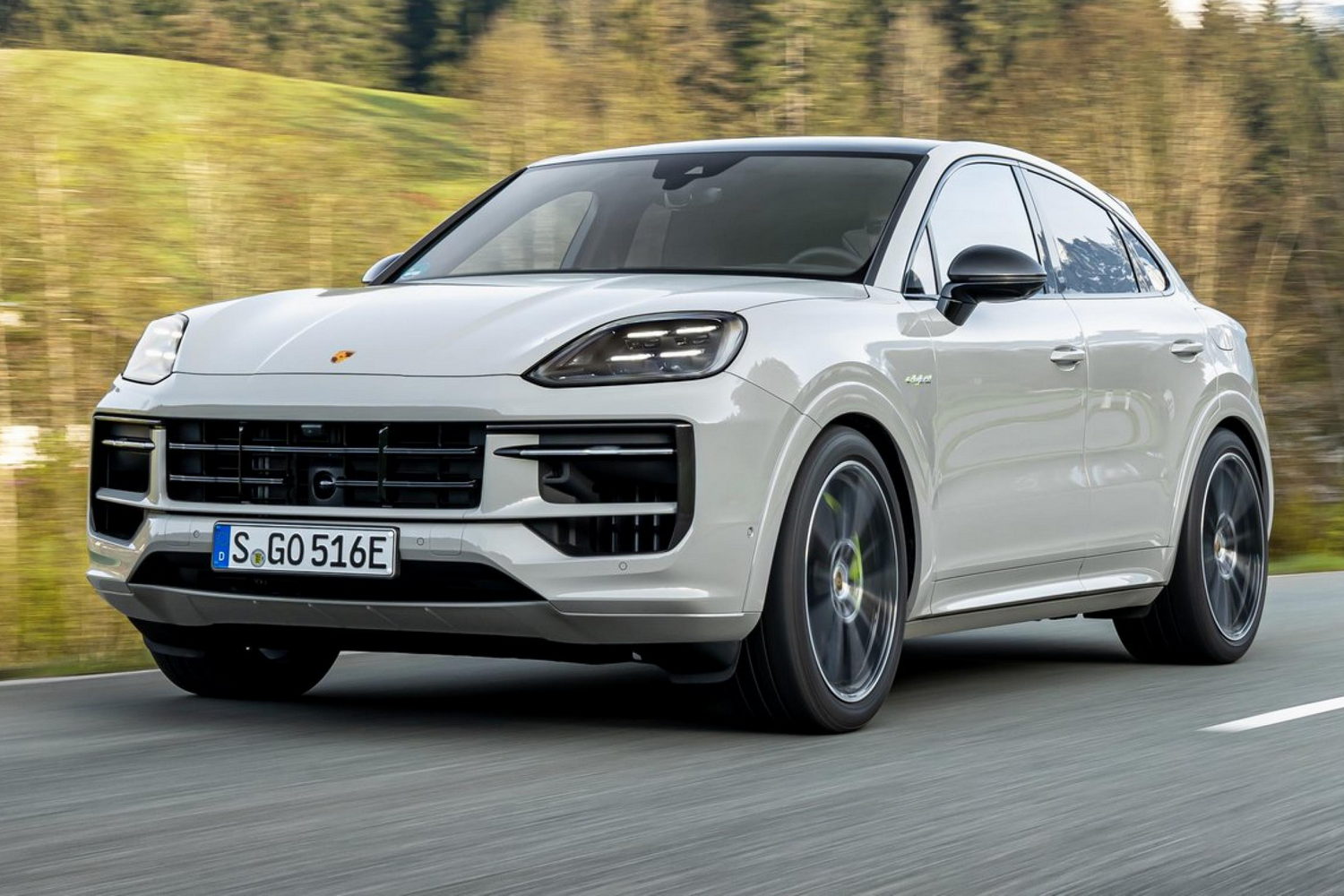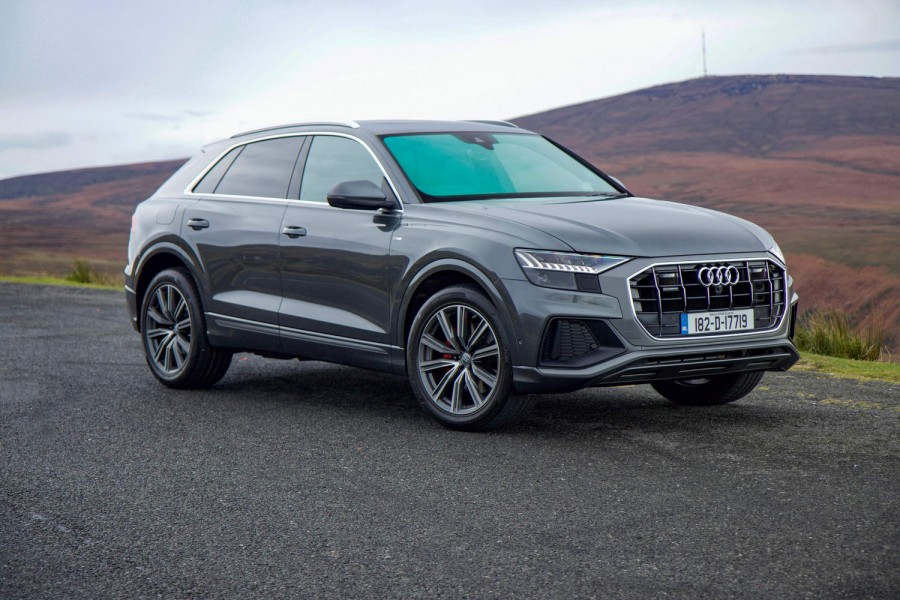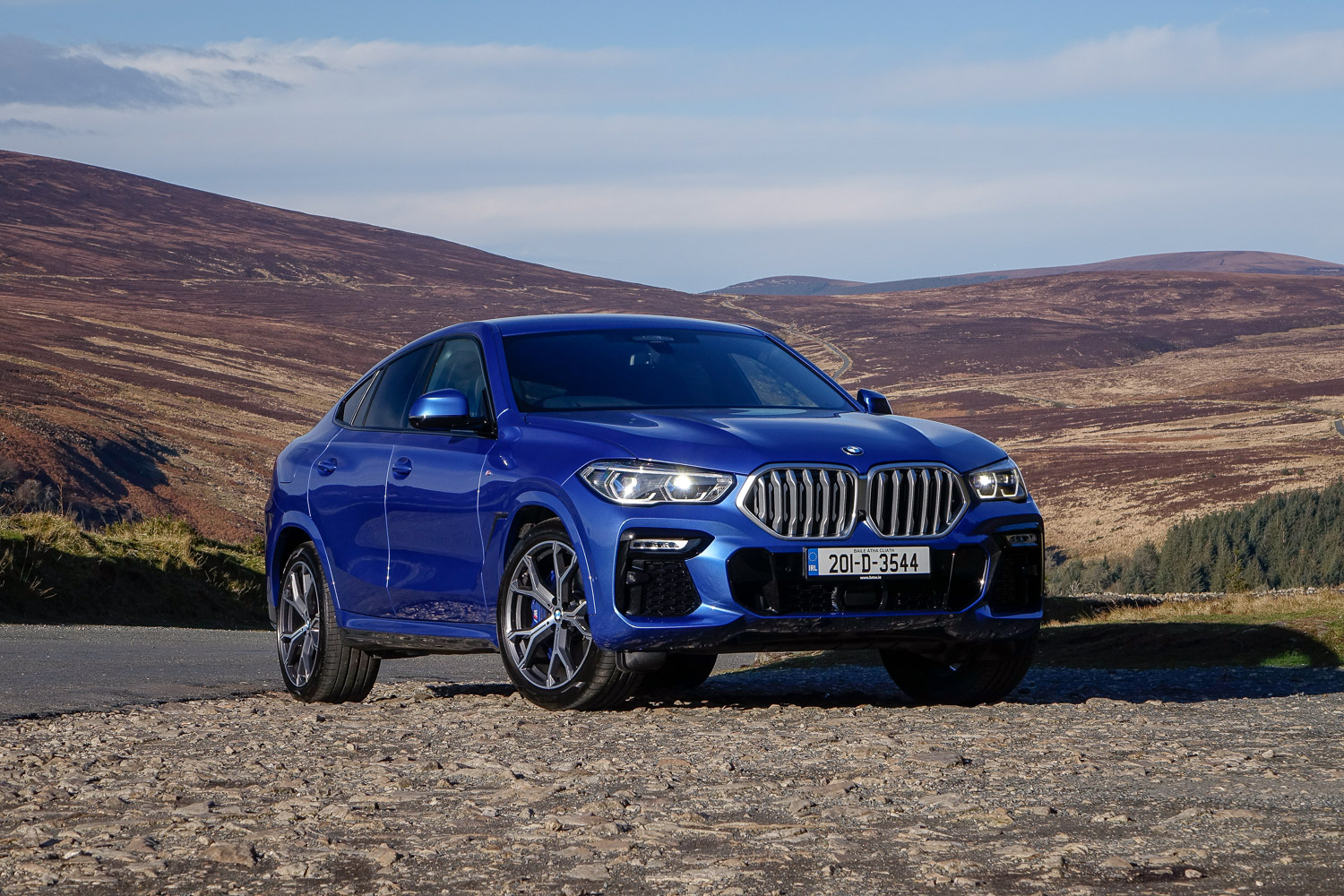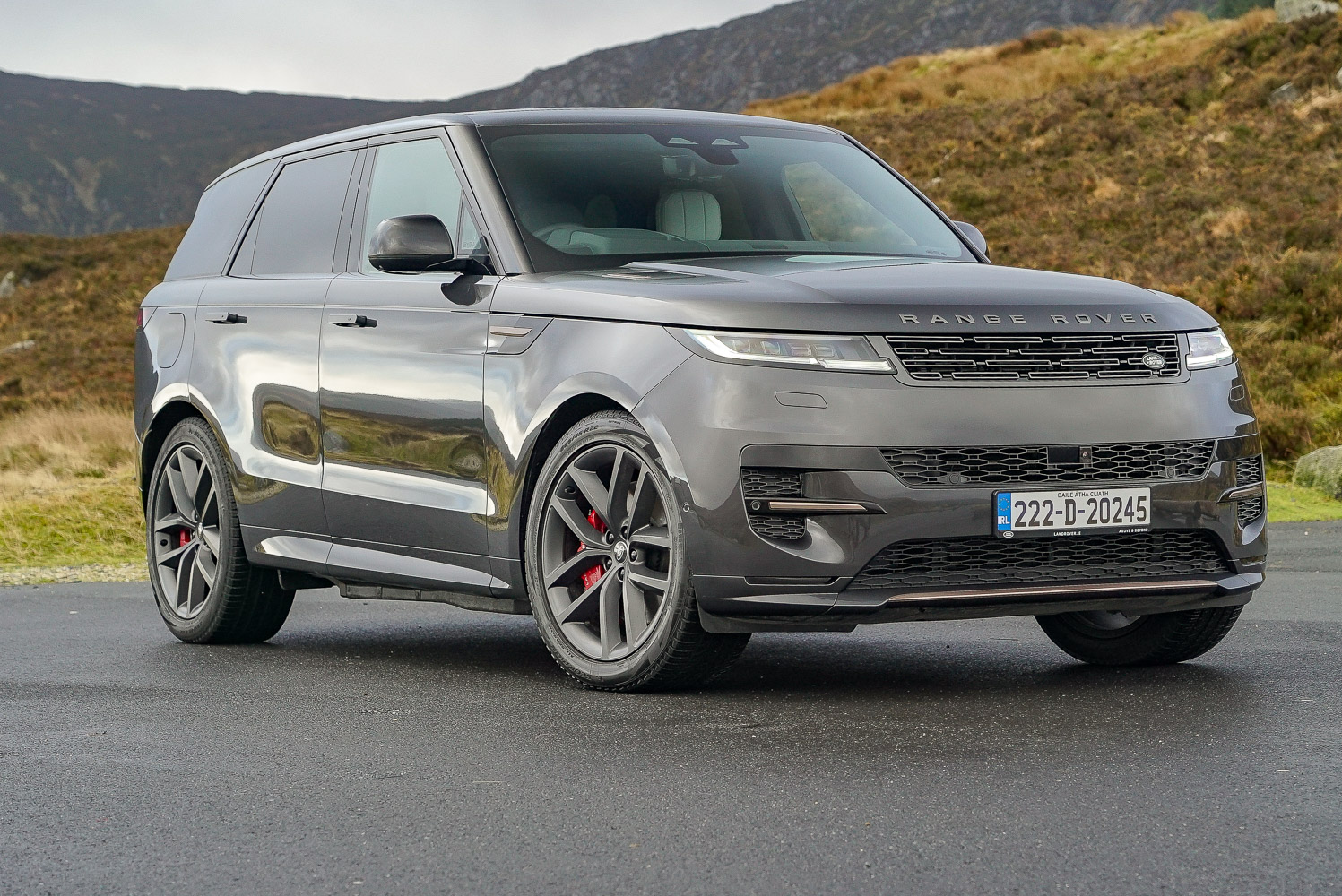In many ways, the Porsche Cayenne Coupe doesn't make much sense. A smaller boot makes it less practical than the conventional Cayenne and, unless you love the styling, there's little else to commend it. Yet the Coupe is a surprisingly popular choice among customers - particularly in plug-in hybrid E-Hybrid form - and it has just had a revamp to keep it in line with the new-look SUV. Is it worth the premium over the standard car?
In the metal
No, dear reader, you need not adjust your monitor/phone/tablet/whatever else you might be reading this through. This is indeed the new Porsche Cayenne Coupe, and it looks quite similar to the old car. Of course, that's partly because the basic structure is the same, but there are one or two new features of note.
Starting at the front, there's a revised nose with a fresh bonnet and more aggressively styled wheel arches, but the highlight is the new headlights. As standard, you get LED Matrix Headlights, which can dip the beam in the direction of an oncoming vehicle to avoid dazzle, and that's very clever, but HD LED Matrix lights are also available as an option. These can do all sorts of clever things over and above the standard lights, including highlighting the driver's lane of the motorway or picking out hazards with a flash of the lights. They aren't a cheap option, though, at €2,137.
Further back, Porsche has given the Cayenne some new alloy wheel designs in a choice of 20-, 21- and 22-inch diameters, while there are some new paint colours, too.
Porsche has fitted a new rear bumper, too, but the biggest changes to the Cayenne are found in the cabin. There, Porsche has fitted the digital instrument display from the Taycan, as well as changing the air vents, climate control switchgear and dashboard design.
Naturally, the new instrument display is one of the bigger talking points, replacing the old 'hybrid' display that merged analogue and digital displays. The new system is sharp and easy to configure, which is all to the good, but we don't think it's a substantial step forward and the lack of a hood on the binnacle makes the dashboard feel a bit... bald, somehow.
The arrival of the new instrument display has also prompted Porsche to move the gear lever and the start button to the dashboard, which is an interesting move. Again, it apes the Taycan, but it means you can't see them from behind the wheel, and that might catch out some drivers when they first get in.
In turn, the movement of the gear selector has allowed Porsche to redesign the centre console, which feels a little less cluttered than before and now comes with a fresh climate control panel. Instead of merging all these buttons into the touchscreen Porsche has left us with physical toggle switches for the temperature and some more-or-less conventional buttons for the other functions. That, combined with the digital temperature displays, works really well. Other car makers, take note.
But while Porsche has done plenty to the dashboard design, the company hasn't really touched the central touchscreen, which was already one of the better systems on the market. That remains the case, but there is a new option of a touchscreen just for the passenger. Although it's rather shoehorned into the dashboard design, the system is designed to let front-seat passengers watch films and TV on the move, as well as viewing navigation displays and all the usual media screens. To prevent drivers being distracted by what's showing on the extra screen, Porsche has fitted a film that essentially renders the display invisible from the driver's angle, but it has the unfortunate side-effect of making the screen appear a bit odd from the passenger's angle, too. In truth, the system is a bit of a gimmick, and most customers won't get much value from the €1,291 they'll spend on it.
While the screen might be a bit pointless, though, the Cayenne certainly isn't. Although the interior design has changed, the car is still just as spacious and as practical as before, which means those sitting in the rear seats will have plenty of legroom and even sufficient headroom, despite the roofline of the Coupe body.
Boot space is unchanged, too, and the Cayenne E-Hybrid Coupe's 404-litre load space is much the same as before. It's worth noting that a Cayenne E-Hybrid SUV is more practical, with 545 litres of carrying capacity when all five seats are upright. And it's also worth remembering that the E-Hybrid models have less space than their purely petrol-powered siblings. A 'basic' Cayenne Coupe with the V6 petrol engine has a 554-litre boot, for example.
Driving it
Of all the new Cayenne models released so far, the S model has had the most dramatic update, thanks to its whopping new V8 engine, but the E-Hybrid model isn't far behind. Porsche has made some significant changes to the plug-in hybrid system, which now has a much larger battery and a more powerful electric motor to work alongside the 3.0-litre petrol engine.
As a result, the plug-in hybrid system is now 8hp more powerful overall, with 470hp at the disposal of the driver's right foot. That doesn't sound like much, but it brings the E-Hybrid to within four horsepower of the V8-powered Cayenne S. That means, despite a fairly chunky 265kg difference in weight, the E-Hybrid Coupe can get pretty close to its stablemate in terms of performance. Where the S Coupe takes 4.7 seconds to get from 0-100km/h, the E-Hybrid Coupe is only two-tenths slower - an imperceptible difference in the real world. Intriguingly, if you choose the conventional SUV, rather than the Coupe, the tables are turned and the E-Hybrid is a tenth faster than the S. Apparently, that's because the Coupe models come with the Sport Chrono package as standard, which means they get launch control, allowing the S to put its power down more effectively.
Anyway, the fact remains that there's little to choose between the E-Hybrid and the S in terms of performance. That's thanks largely to the new and more powerful electric motor, which now has an extra 40hp, giving Cayenne E-Hybrid drivers 176hp to play with even when the petrol engine is switched off.
But though the E-Hybrid and the S are closely matched in the performance stakes, there's much more difference in economy. Porsche has substantially increased the size of the E-Hybrid's battery from 17.9kWh to 25.9kWh, and that meant our test car had an official electric-only range of 86km. Naturally, achieving such a figure in the real world isn't always possible, but our test suggested 50km would be easily achievable, while 60km should be doable for those with a light right foot. And when the range is exhausted, customers will be happy to find a new 11kW onboard charging system that allows the Cayenne to take on charge more quickly, assuming you can hitch up to an 11kW-plus charger.
With that new hybrid system on board, more customers should be able to use the Cayenne's electric capability more of the time, and that has a noticeable impact on economy. The official figures suggest those who charge regularly and mostly drive short distances will burn just 1.9 litres every 100km, and though that's probably pie in the sky for most, those whose lifestyles suit a hybrid system will be able to achieve far better economy than the S, which only manages something in the region of 10.7 litres/100km.
If you drive the car predominantly on petrol power, though, the difference in economy is significantly less marked, partly because the 3.0-litre petrol engine is arguably a little small for a car that weighs almost 2.5 tonnes. Running a larger, lazier 4.0-litre V8 engine in the lighter S is only marginally less fuel-efficient in the real world.
Both cars, though, are spectacularly good to drive, and in that the new car isn't so different from the old Cayenne Coupe. Porsche has worked on the suspension a bit, trying to improve the comfort of the Cayenne without damaging its brilliant road holding, and the overhaul has largely worked. Admittedly, our test car came with the adaptive air suspension upgrade, so it still performed admirably, soaking up the vast majority of the bumps quite happily. In fairness, the roads of our test route were fairly smooth, and the Cayenne was already pretty comfortable, but the new model feels a smidgen more supple over a greater breadth of surfaces.
It doesn't glide like a Rolls-Royce, though, and Porsche says that's intentional. The company's engineers are keen drivers, and they want their customers to know exactly what the wheels are doing without being jolted or jarred. Whether that really was the goal or not, they have achieved it perfectly, and everything about the Cayenne provides feedback without damaging ride comfort.
Of course, it's at its most comfortable in the softer driving modes, and owners have plenty of those to choose from. Not only does the little rotary dial on the steering wheel control the suspension, but it also affects the hybrid system, offering a choice between fully electric or hybrid propulsion, as well as the Sport and Sport Plus driving modes.
Body control and handling is sublime in every setting - Porsche's trademark steering feel and the natural stability of the Cayenne see to that - but the Sport and Sport Plus settings give it a huge amount of poise. Porsche says it targeted zero body roll in the Sport Plus setting, and it has almost achieved that. The car stays remarkably flat through the bends, but you pay for that with much stiffer suspension. It's arguably better to stick with Sport mode, which still offers immense stability but a little more compliance through the suspension.
And the Cayenne Coupe is remarkably stable. Even Porsche's engineers admit the SUV is a little less prone to understeer than the supposedly sportier Coupe, but the Coupe has a slightly wider rear track and a lower centre of gravity, which makes it less prone to lean during brisk cornering. The differences between the SUV and Coupe are small, but just about perceptible if you drive the cars back to back.
However, this version of the Cayenne Coupe does have one small issue, and that isn't the engine - the 3.0-litre V6 actually sounds quite pleasant - but the brakes. Because Porsche uses the electric motor to slow the car during the first few millimetres of the brake pedal's travel, recharging the battery in the process, the pedal feel is quite strange. When the callipers are finally employed to do their job, it's fine, but there's an unusual feel to the pedal at first, and it doesn't inspire much confidence. As gripes go, though, this is a very minor one, and even that can't spoil what is really a fantastic car to drive.
What you get for your money
The E-Hybrid is by far the most appealing member of the Cayenne Coupe range in terms of value for money. Where the supposedly 'basic' Cayenne Coupe - the standard V6 version - comes in at €136,403, the E-Hybrid is a whopping €36,000 cheaper, at just over €100,000.
Of course, it's cheaper still to go for the standard SUV, which costs just under €98,000, but a difference of less than €3,000 is unlikely to trouble buyers who fall in love with the Coupe design.
And don't go thinking you'll miss out on equipment by choosing the cheapest model in the range. There are subtle differences in specification when you compare the different models, but generally they're much of a muchness. All come with the digital instrument display, navigation and climate control, as well as smart upholstery and a few toys. Porsche is notorious for its tempting options, though, so expect to pay a few more euros to get the car you really want.
Summary
Despite all the changes to the cabin, the new Porsche Cayenne Coupe doesn't feel dramatically different from the old car, but that's no bad thing. While the Coupe might not have the luggage capacity of the standard SUV, it's great to drive and relatively practical, even if you don't get an awful lot for the extra money. But while the SUV is perhaps easier to recommend, those who loved the old Coupe will love this version just as much.
And the E-Hybrid will certainly be the most appealing powertrain for most buyers. Were money and running costs no object, we'd go for the V8-powered Cayenne S instead, but precious few people can honestly say the cost doesn't matter. With a vastly reduced price tag, a great V6 engine and only 4hp less than the S, the E-Hybrid is much better value for money. Even if it is less spacious.





































